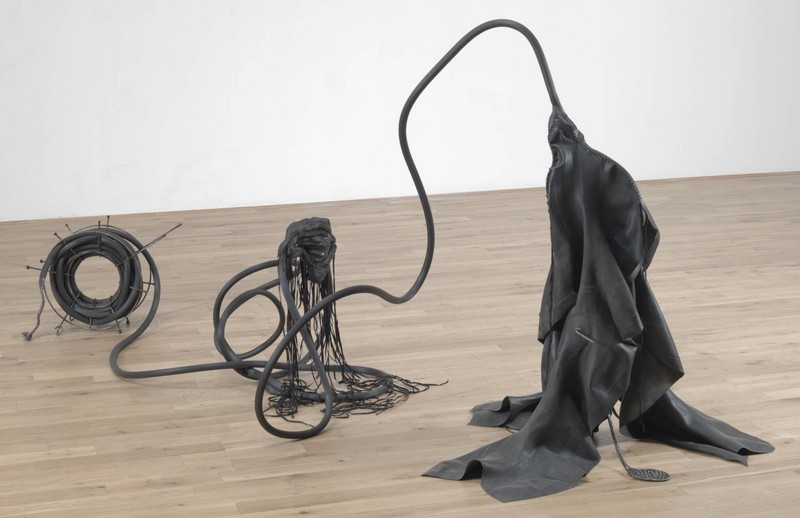Nicholas Hlobo
16 May 2014 - 10 Jan 2016
Nicholas Hlobo weaves, plaits and stitches together disparate materials such as satin ribbon and the inner tubes of car tyres to create intricate and seductively tactile sculptures and drawings.
Hlobo always titles his work in his native language, Xhosa, an Nguni language widely spoken in South Africa. Attracted to the formal qualities of the grammar, the sounds of the words, and the linguistic flexibility of Xhosa, Hlobo’s use of the language, with all its poetic idioms, proverbs, and double entendres, is as much about defining himself as it is an effort to emphasise the challenges of openly talking about homosexuality inSouth Africa.
The process of making is fundamental to Hlobo’s work. In his sculptures and drawings he utilises techniques such as stitching and weaving, which inSouth Africa are traditionally undertaken by women. His choice of materials is similarly charged with meaning. The old and punctured inner tubes of car tyres that he gathers from repair shops inJohannesburgare a symbol of industrialisation and the urban experience. Resembling condoms, the inner tubes are also a symbol of masculinity and sex, something that is made explicit by Hlobo’s use of phallus and sperm shapes, and forms suggesting orifices, umbilical cords and internal organs. The satin ribbon that he uses to make his marks on paper suggests femininity, domesticity and unification, in contrast to the more ‘masculine’ materials that it binds together. The ribbon, and the way it is used, challenges gender-based assumptions about divisions of labour and introduces a more ambiguous approach to sexuality.
Nicholas Hlobo was born in 1975 in Cape Town, South Africa. He lives and works in Johannesburg.
Curated by Kerryn Greenberg
Hlobo always titles his work in his native language, Xhosa, an Nguni language widely spoken in South Africa. Attracted to the formal qualities of the grammar, the sounds of the words, and the linguistic flexibility of Xhosa, Hlobo’s use of the language, with all its poetic idioms, proverbs, and double entendres, is as much about defining himself as it is an effort to emphasise the challenges of openly talking about homosexuality inSouth Africa.
The process of making is fundamental to Hlobo’s work. In his sculptures and drawings he utilises techniques such as stitching and weaving, which inSouth Africa are traditionally undertaken by women. His choice of materials is similarly charged with meaning. The old and punctured inner tubes of car tyres that he gathers from repair shops inJohannesburgare a symbol of industrialisation and the urban experience. Resembling condoms, the inner tubes are also a symbol of masculinity and sex, something that is made explicit by Hlobo’s use of phallus and sperm shapes, and forms suggesting orifices, umbilical cords and internal organs. The satin ribbon that he uses to make his marks on paper suggests femininity, domesticity and unification, in contrast to the more ‘masculine’ materials that it binds together. The ribbon, and the way it is used, challenges gender-based assumptions about divisions of labour and introduces a more ambiguous approach to sexuality.
Nicholas Hlobo was born in 1975 in Cape Town, South Africa. He lives and works in Johannesburg.
Curated by Kerryn Greenberg

